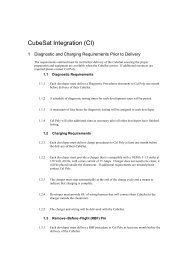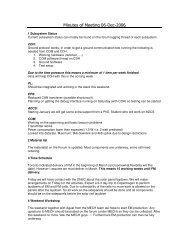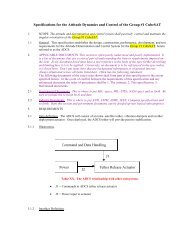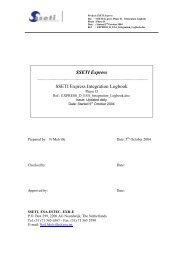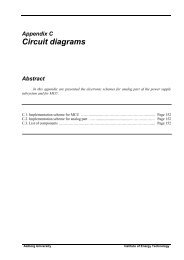The P-POD Payload Planner's Guide
The P-POD Payload Planner's Guide
The P-POD Payload Planner's Guide
You also want an ePaper? Increase the reach of your titles
YUMPU automatically turns print PDFs into web optimized ePapers that Google loves.
P-<strong>POD</strong> <strong>Payload</strong> Planner’s <strong>Guide</strong>: Revision B – 5/15/00 9 of 19<br />
4.1.2. Operations <strong>Guide</strong><br />
<strong>The</strong> CubeSat design team must submit a formal operations guide to the P-<strong>POD</strong> team in<br />
order to outline the primary mission and identify the functions of the CubeSat’s payload.<br />
This guide should also document the CubeSat’s compliance with all of the requirements<br />
set forth in this document. Expected behavior of the CubeSat during the entire mission<br />
(Pre-deployment, deployment, post-deployment) shall also be documented within this<br />
guide. Uplink and downlink frequencies shall also be clearly documented to avoid<br />
communications error with the other CubeSats on the mission.<br />
All communications with the CubeSats are left to the CubeSat design teams. P-<strong>POD</strong> shall<br />
not provide any communication with any of the CubeSats prior, during, or after they are<br />
deployed. However, the deployer will relay launch information back to the ground<br />
station, which will verify if the CubeSats were properly deployed from the system.<br />
4.1.3. Physical Constraints<br />
This section of the document outlines the method in which all CubeSats are loaded into<br />
the deployer to achieve proper dormancy in each satellite. A detailed procedure must be<br />
submitted to the P-<strong>POD</strong> design team, prior to launch, that will explain the proper loading<br />
procedure for each CubeSat in order to ensure that all power is turned off when loaded<br />
into the deployer. As stated in Section 3, all CubeSat operations (electromagnetic,<br />
electrical, etc.) must be suspended until the CubeSat is clear of the launch tube during<br />
deployment.<br />
4.2. Deployment Requirements<br />
Because no single CubeSat’s mission is seen as more important than any other during the<br />
mission, no CubeSat design team shall be given the choice of deployment times or<br />
vectors. All CubeSat design teams must agree that their mission may begin at any time,<br />
and should be ready to begin their mission within the defined launch window. Because<br />
each P-<strong>POD</strong> tube will contain up to three CubeSats, the CubeSat design teams must<br />
coordinate with one another concerning which tubes they will mount into. <strong>The</strong> P-<strong>POD</strong><br />
design team will assign tubes and have the ultimate decision if any conflicts arise.<br />
CubeSats may only begin their missions upon exiting the deployment tube. No CubeSat<br />
may self-actuate until clear of the deployer. Also, no exterior components of the<br />
CubeSats, such as antennas or other devices, are allowed to contact the deployment tube.<br />
See CubeSat Specifications, Appendix A for details.<br />
4.3. Post Deployment Requirements<br />
Once free of the deployer, the CubeSat should activate and begin communication with its<br />
ground station. At this time no ground station has been established for CubeSat<br />
communication, and we will supply all interested parties this information as soon as it<br />
becomes available.



